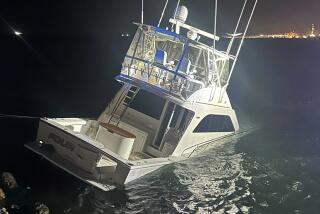San Clemente Island Mystery : Lawsuit Seeks to Prove Navy Role in Boat Deaths
During Boyd Reber’s call to his wife at 7:30 p.m., Feb. 23, 1986, he told her that the fishing for soupfin shark at Mail Point was good, that he loved her and that he would call her again as soon as he could.
That was the last time Cynthia Reber heard from her husband.
On March 2, Reber’s body was found floating about 20 yards offshore near San Clemente Island’s Mail Point, his boat mysteriously demolished. The body of Reber’s first mate, Frank Germano, was found the next day among the rocks on the shore.
An autopsy determined that Reber suffered a blow to the head that knocked him into the water, where he drowned--while in a semiconscious or unconscious state--in 35 feet of water, and that his death occurred between Feb. 25 and 28. Germano was killed instantly by a blow to the head and torso, which destroyed one lung and his liver.
The stern of the San Pedro-based Cindy Fay was found in 35 feet of water and about 1,100 feet offshore during a search by Reber’s friends. The rest of the boat washed onto shore, where it was smashed by rocks.
Cynthia Sue Reber has filed a multimillion-dollar wrongful-death lawsuit against the United States, charging that Navy ammunition in the area caused the Cindy Fay to explode. Attorneys for the plaintiffs presented their opening statement Wednesday in the 9th U. S. District Court in San Diego.
According to a trial brief submitted by attorneys Barry Capello and Michael McCann, “the harm to Boyd Reber and the Cindy Fay was caused by one of two sources, both under the control of the United States: either unexploded ordnance or a live shell.”
In his opening statement, Capello said that Navy ships, which use the southern end of San Clemente Island as a bombardment range, were firing at targets in Pyramid Cove about the time Reber died. The fully charged, 5-inch shells they were firing had a 26,000-yard range and could easily have struck the Cindy Fay, which was about 22,000 yards away, Capello said.
Assistant U. S. Atty. Warren A. Schneider declined to make an opening statement, but a trial brief submitted by Schneider stated that “evidence will show heavy surf is the most likely explanation.” The brief also added that “Mr. Reber’s conduct is a very likely cause of the accident.”
Example of Cautiousness
But accounts by Reber’s relatives and friends portrayed him as meticulous and safety-conscious, a man who once cut free his nets because he was unable to haul them in fast enough to escape inclement weather.
Tim Houshar, who considered Reber one of his closest friends, testified that the accident could only have happened for “reasons beyond (Reber’s) control.”
Capello said that Reber might have inadvertently caught unexploded ordnance in his net and that it exploded aboard the Cindy Fay. Several areas around San Clemente Island are posted by the Navy as danger zones, but no warnings were given--outside Pyramid Cove--to civilians about the naval shore-bombardment exercises at the time the Cindy Fay was in the area, Capello said. The Coast Guard is responsible for keeping civilian vessels out of the area when naval exercises are being conducted.
“Unknown to Reber, the entire island would be subject to virtual open warfare,” Capello told Judge J. Lawrence Irving, who is hearing the case without a jury. Just one week after Reber’s death, said Capello, the destroyer Merrill fired shells that landed far outside the target zone, about a mile south of Mail Point.
But Schneider declined to confirm the possibility that Navy ships may have missed their marks during target practice and hit the Cindy Fay. “Almost anything can happen, but I don’t know whether it did or not,” he said. “I’m not sure we have any specific conclusions as to what happened.”
Capello also said he will bring evidence to show that the Navy and the Coast Guard are involved in a cover-up of the circumstances surrounding Reber’s death. Wreckage from the Cindy Fay that was first retrieved by the frigate Bronstein was never turned over to the Coast Guard and has now disappeared, Capello said.
On behalf of herself and the couple’s daughter, Courtney, now 7, Cynthia Reber is seeking $2.5 million for loss of income and $4 million for pain and suffering.
More to Read
Sign up for Essential California
The most important California stories and recommendations in your inbox every morning.
You may occasionally receive promotional content from the Los Angeles Times.










